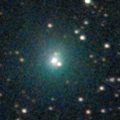
|
Now it is bright as 10.8 mag (Aug. 9, Maik Meyer). It is expected to brighten up to 8 mag in autumn. In the Northern Hemisphere, it stays observable for a long time while the comet is brightening. In the Southern Hemisphere, it it not observable until mid September.
Date(TT) R.A. (2000) Decl. Delta r Elong. m1 Best Time(A, h)
Aug. 17 4 5.62 57 53.5 1.364 1.482 75 10.1 3:48 (216, 55)
Aug. 24 3 47.60 57 1.8 1.183 1.466 83 9.7 3:56 (211, 62)
|
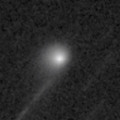
|
Now it is 12.0 mag (Aug. 9, Maik Meyer). It will brighten up to 10.5 mag and it will be observable in good condition from autumn to winter.
Date(TT) R.A. (2000) Decl. Delta r Elong. m1 Best Time(A, h)
Aug. 17 2 41.62 19 20.2 2.908 3.234 99 11.4 3:48 (309, 67)
Aug. 24 2 38.86 21 14.3 2.784 3.217 106 11.3 3:56 (327, 74)
|

|
It has not been observed yet in this apparition. Now it is fainter than 21.5 mag (Aug. 4, Erwin Schwab). It was expected to brighten up to 12 mag from August to September. But actually, it must be much fainter than expected. It is observable in good condition in the Northern Hemisphere. In the Southern Hemisphere, it will be getting lower after this, and it will be unobservable in September.
Date(TT) R.A. (2000) Decl. Delta r Elong. m1 Best Time(A, h)
Aug. 17 4 5.66 31 27.9 1.145 1.366 78 12.1 3:48 (265, 57)
Aug. 24 4 27.99 34 47.3 1.130 1.376 79 12.0 3:56 (260, 60)
|

|
Now it is 12.7 mag (Aug. 12, Piotr Guzik). It will brighten up to 11.5 mag in autumn. In the Northern Hemisphere, it will be observable in excellent condition. In the Southern Hemisphere, it will be extremely low from autumn to winter.
Date(TT) R.A. (2000) Decl. Delta r Elong. m1 Best Time(A, h)
Aug. 17 1 52.35 12 0.6 0.703 1.442 113 12.5 3:48 (345, 66)
Aug. 24 2 5.11 16 10.7 0.664 1.430 115 12.2 3:56 (358, 71)
|

|
Now it is 13.6 mag (Aug. 6, Hirohisa Sato). It is expected to brighten up to 7 mag in 2020. It is a bit fainter than this ephemeris recently.
Date(TT) R.A. (2000) Decl. Delta r Elong. m1 Best Time(A, h)
Aug. 17 5 8.06 20 49.3 3.879 3.583 65 12.5 3:48 (271, 40)
Aug. 24 5 13.71 21 40.0 3.712 3.516 71 12.4 3:56 (275, 46)
|

|
It brightened rapidly. Now it is very bright as 12.7 mag (Aug. 5, Hidetaka Sato). It stays at 12.5 mag until September. In the Southern Hemisphere, it stays observable in the low sky until it becomes fainter than 18 mag in winter. It is not observable at all in the Northern Hemisphere.
Date(TT) R.A. (2000) Decl. Delta r Elong. m1 Best Time(A, h)
Aug. 17 8 20.28 -27 19.2 1.973 1.458 45 12.8 3:48 (287,-25)
Aug. 24 8 41.30 -32 35.1 1.939 1.482 48 12.9 3:56 (293,-25)
|

|
Now it is bright as 12.6 mag (Aug. 9, Charles Morris). Richard Miles reported that it brightened by 2 mag in outburst on Aug. 2.
Date(TT) R.A. (2000) Decl. Delta r Elong. m1 Best Time(A, h)
Aug. 17 1 0.16 16 12.7 5.158 5.772 122 13.3 3:21 ( 0, 71)
Aug. 24 0 58.89 16 18.2 5.073 5.772 129 13.2 2:53 ( 0, 71)
|

|
Appearing in the morning sky. It is observable at 14 mag in good condition in autumn.
Date(TT) R.A. (2000) Decl. Delta r Elong. m1 Best Time(A, h)
Aug. 17 7 21.77 17 50.2 3.056 2.292 34 13.6 3:48 (256, 11)
Aug. 24 7 35.38 17 11.1 3.033 2.317 37 13.7 3:56 (259, 15)
|

|
Now it is 13.8 mag (Aug. 8, Chris Wyatt). It stays 13-14 mag for a long time in 2019. In the Southern Hemisphere, it is observable in excellent condition. In the Northern Hemisphere, it is not observasble until summer in 2020.
Date(TT) R.A. (2000) Decl. Delta r Elong. m1 Best Time(A, h)
Aug. 17 8 37.88 -62 52.5 3.084 3.033 77 13.9 3:48 (326,-38)
Aug. 24 8 48.19 -65 5.2 3.085 3.039 77 13.9 3:56 (329,-36)
|
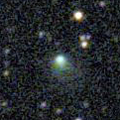
|
Now it is 13.8 mag (Aug. 3, Chris Wyatt). It will be observable at 13.5 mag in good condition in autumn.
Date(TT) R.A. (2000) Decl. Delta r Elong. m1 Best Time(A, h)
Aug. 17 17 19.46 -7 37.2 1.332 1.985 115 14.0 20:18 ( 14, 46)
Aug. 24 17 24.86 -8 38.9 1.364 1.956 110 13.9 20:08 ( 18, 45)
|

|
It brightened up to 7.7 mag in June in 2018 (June 19, Juan Jose Gonzalez). Now it is fading. It has already faded down to 14.8 mag (Aug. 8, Chris Wyatt). In the Southern Hemisphere, it stays observable for a long time until the comet will fade out. In the Northern Hemisphere, it is not observable for a long time until autumn when the comet fades out down to 16 mag.
Date(TT) R.A. (2000) Decl. Delta r Elong. m1 Best Time(A, h)
Aug. 17 6 51.84 -28 50.4 4.945 4.514 59 14.2 3:48 (299, -9)
Aug. 24 6 55.46 -29 6.1 4.960 4.571 61 14.3 3:56 (303, -4)
|

|
It brightened rapidly up to 10 mag in June. Now it is not observable. It will appear in the morning sky in October. But it will be fainter than 18 mag at that time.
Date(TT) R.A. (2000) Decl. Delta r Elong. m1 Best Time(A, h)
Aug. 17 9 45.64 20 7.7 2.663 1.661 6 14.2 20:18 (126,-13)
Aug. 24 9 55.70 16 57.0 2.726 1.725 6 14.8 3:56 (239,-12)
|

|
It will pass only 0.05 a.u. from Sun on Aug. 31, then it will brighten up to 5.5 mag. It is not observable on the ground. But it will be visible in the SOHO spacecraft's images.
Date(TT) R.A. (2000) Decl. Delta r Elong. m1 Best Time(A, h)
Aug. 17 11 41.22 -5 58.2 0.918 0.591 35 16.5 20:18 ( 88, -7)
Aug. 24 11 19.77 -0 46.7 0.889 0.371 21 14.3 20:08 ( 98,-12)
|

|
Now it is 14.4 mag (Aug. 8, Chris Wyatt). In the Southern Hemisphere, it is observable for a long time. It stays low in the Northern Hemisphere.
Date(TT) R.A. (2000) Decl. Delta r Elong. m1 Best Time(A, h)
Aug. 17 0 4.71 -46 5.5 3.481 4.269 136 14.7 2:26 ( 0, 9)
Aug. 24 23 57.08 -45 59.6 3.483 4.293 138 14.7 1:51 ( 0, 9)
|

|
Now it is 14.3 mag (July 23, Chris Wyatt). It will be fading slowly after this. It is observable in excellent condition in the Southern Hemisphere. It will never be observable after this in the Northern Hemisphere.
Date(TT) R.A. (2000) Decl. Delta r Elong. m1 Best Time(A, h)
Aug. 17 13 33.84 -42 42.3 3.905 3.809 77 14.8 20:18 ( 43, -9)
Aug. 24 13 34.08 -42 58.6 4.041 3.843 71 14.9 20:08 ( 45,-11)
|
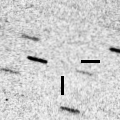
|
Peculiar asteroid moving along a cometary orbit. Now it is 15.9 mag (Aug. 11, Katsumi Yoshimoto). It approaches to Earth down to 0.37 a.u. in mid August. Then it brightens up to 15 mag and will be observable in good condition.
Date(TT) R.A. (2000) Decl. Delta r Elong. m1 Best Time(A, h)
Aug. 17 22 21.73 -26 53.7 0.378 1.380 164 14.8 0:51 ( 0, 29)
Aug. 24 19 31.61 -30 31.7 0.424 1.359 138 15.6 21:12 ( 0, 25)
|

|
Now it is 16.2 mag (Aug. 9, Charles Morris). It is observable at 16 mag in good condition from summer to autumn. It locates somewhat low in the Southern Hemisphere.
Date(TT) R.A. (2000) Decl. Delta r Elong. m1 Best Time(A, h)
Aug. 17 3 9.36 25 3.1 1.771 2.066 91 15.9 3:48 (287, 66)
Aug. 24 3 18.85 25 55.7 1.712 2.079 96 15.9 3:56 (294, 71)
|
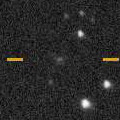
|
Now it is 16.6 mag (May 10, Mount John Observatory, Lake Tekapo). It stays 16 mag for a long time from 2019 to 2020. It is observable in excellent condition in the Southern Hemisphere. It is hardly observable in the Northern Hemisphere.
Date(TT) R.A. (2000) Decl. Delta r Elong. m1 Best Time(A, h)
Aug. 17 11 7.10 -54 42.6 3.791 3.585 70 15.9 20:18 ( 43,-35)
Aug. 24 11 11.97 -55 28.9 3.818 3.567 68 15.9 20:08 ( 43,-37)
|
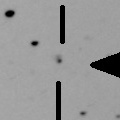
|
Asteroid, but it brightened rapidly. Now it is 15.9 mag (Aug. 8, ATLAS-MLO, Mauna Loa). It is observable in excellent condition in the Southern Hemisphere. In the Northern Hemisphere, it locates extremely low for a while.
Date(TT) R.A. (2000) Decl. Delta r Elong. m1 Best Time(A, h)
Aug. 17 20 51.02 -43 11.7 5.535 6.420 148 15.9 23:08 ( 0, 12)
Aug. 24 20 41.23 -43 6.7 5.583 6.419 142 16.0 22:31 ( 0, 12)
|
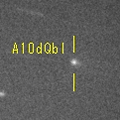
|
Now it is 15.6 mag (Aug. 3, Chris Wyatt). It stays observable in good condition while the comet will be fading slowly after this.
Date(TT) R.A. (2000) Decl. Delta r Elong. m1 Best Time(A, h)
Aug. 17 2 58.01 10 6.5 1.743 2.141 98 16.0 3:48 (315, 58)
Aug. 24 3 7.37 9 33.0 1.702 2.168 103 16.0 3:56 (326, 61)
|

|
Now it is 16.2 mag (Aug. 10, Ken-ichi Kadota). It stays 15-16 mag for a long time until 2021.
Date(TT) R.A. (2000) Decl. Delta r Elong. m1 Best Time(A, h)
Aug. 17 21 2.34 -34 7.3 4.153 5.103 157 16.2 23:19 ( 0, 21)
Aug. 24 20 52.61 -33 35.6 4.164 5.077 151 16.2 22:42 ( 0, 22)
|
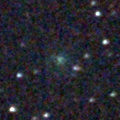
|
It brightened rapidly up to 11.2 mag from May to June (May 28, Chris Wyatt). Now it is fading. But it is still bright as 13.9 mag (July 23, Chris Wyatt). In the Southern Hemisphere, it stays observable in the evening sky for a long time after this while the comet will be fading. It is not observable at all in the Northern Hemisphere.
Date(TT) R.A. (2000) Decl. Delta r Elong. m1 Best Time(A, h)
Aug. 17 11 45.47 -37 23.1 2.229 1.908 58 16.2 20:18 ( 59,-23)
Aug. 24 12 9.65 -36 25.5 2.359 1.972 55 16.7 20:08 ( 59,-21)
|

|
It has not been observed yet in this apparition. It will brighten up to 15.5 mag and it will be observable in good condition in autumn.
Date(TT) R.A. (2000) Decl. Delta r Elong. m1 Best Time(A, h)
Aug. 17 0 6.16 -5 40.8 1.782 2.668 144 16.4 2:27 ( 0, 49)
Aug. 24 0 5.47 -6 7.5 1.712 2.641 150 16.2 1:59 ( 0, 49)
|

|
Now it is 16.5 mag (July 27, Kevin Hills). It will brighten up to 14 mag in winter. It stays observable for a long time in the Southern Hemisphere. In the Northern Hemisphere, it is not observable for a long time until August in 2020.
Date(TT) R.A. (2000) Decl. Delta r Elong. m1 Best Time(A, h)
Aug. 17 14 57.43 -37 8.3 2.740 2.909 89 16.3 20:18 ( 35, 6)
Aug. 24 14 54.57 -37 53.3 2.801 2.854 82 16.3 20:08 ( 38, 3)
|

|
It approached to Earth down to 0.3 a.u. in mid February, and brightened up to 5.5 mag (Feb. 13, Juan Jose Gonzalez). Now it is fading. It has already faded down to 16.6 mag (Aug. 2, Ken-ichi Kadota).
Date(TT) R.A. (2000) Decl. Delta r Elong. m1 Best Time(A, h)
Aug. 17 4 34.29 40 40.9 3.046 2.890 71 16.3 3:48 (247, 53)
Aug. 24 4 28.01 41 21.3 2.985 2.964 79 16.5 3:56 (246, 61)
|

|
First return of a new periodic comet which brightened up to 16.5 mag in 2009. It has not been recovered yet in this apparition. It will brighten up to 16 mag in autumn. It is observable in good condition in the Northern Hemisphere. It locates low in the Southern Hemisphere.
Date(TT) R.A. (2000) Decl. Delta r Elong. m1 Best Time(A, h)
Aug. 17 5 29.01 28 15.8 1.464 1.308 60 16.6 3:48 (260, 39)
Aug. 24 5 59.44 27 46.6 1.439 1.288 60 16.4 3:56 (261, 40)
|

|
Fading now. In the Southern Hemisphere, it stays observable for a long time until it fades out. In the Northern Hemisphere, it will not be observable after this.
Date(TT) R.A. (2000) Decl. Delta r Elong. m1 Best Time(A, h)
Aug. 17 6 39.47 -31 7.2 5.093 4.718 62 16.5 3:48 (302, -9)
Aug. 24 6 41.86 -32 37.2 5.087 4.770 66 16.5 3:56 (308, -4)
|
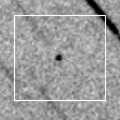
|
It passed the perihelion on July 2. Then it must have brightened up to 13 mag, but it was not observable around that time. In the Northern Hemisphere, it stays observable in excellent condition until December when it becomes fainter than 18 mag. In the Southern Hemisphere, it stays locating low.
Date(TT) R.A. (2000) Decl. Delta r Elong. m1 Best Time(A, h)
Aug. 17 5 4.79 45 45.1 1.006 1.101 66 16.6 3:48 (238, 48)
Aug. 24 4 57.99 47 28.5 1.004 1.205 73 16.7 3:56 (235, 55)
|

|
Now it is 16.0 mag (Aug. 9, Charles Morris). It is expected to be observable at 5-6 mag for a long time from 2022 to 2023. In the Northern Hemisphere, it is not observable at the highlight from 2022 summer to 2023 summer. In the Southern Hemisphere, it stays unobservable for a while. But it will be observable in good condition at the highlight.
Date(TT) R.A. (2000) Decl. Delta r Elong. m1 Best Time(A, h)
Aug. 17 17 10.06 55 16.7 10.998 11.054 90 16.6 20:18 (161, 68)
Aug. 24 17 8.50 54 37.0 10.977 11.007 89 16.6 20:08 (154, 67)
|

|
Now it is 16.8 mag (Aug. 2, Ken Ogawa). It is observable in excellent condition in the Northern Hemisphere. It locates extremely low in the Southern Hemisphere. It will be fading after this, and it will be fainter than 18 mag in late September.
Date(TT) R.A. (2000) Decl. Delta r Elong. m1 Best Time(A, h)
Aug. 17 1 10.82 46 55.6 1.544 2.038 103 16.6 3:32 (180, 78)
Aug. 24 1 12.31 46 45.1 1.535 2.095 108 16.9 3:06 (180, 78)
|

|
Now it is 15.1 mag (Aug. 9, y). Small outburst occurred in early August. It is observable in good condition in the Northern Hemisphere. In the Southern Hemisphere, it stays extremely low for a while.
Date(TT) R.A. (2000) Decl. Delta r Elong. m1 Best Time(A, h)
Aug. 17 14 47.82 29 3.1 5.463 5.228 71 16.8 20:18 ( 95, 49)
Aug. 24 14 50.81 27 41.8 5.586 5.281 67 16.9 20:08 ( 95, 46)
|
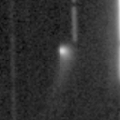
|
Now it is 16.8 mag (Aug. 2, Charles Morris). It will be fading after this. In the Northern Hemisphere, it stays observable in good condition for a long time. In the Southern Hemisphere, it stays extremely low for a long time.
Date(TT) R.A. (2000) Decl. Delta r Elong. m1 Best Time(A, h)
Aug. 17 4 16.35 49 30.9 3.995 3.848 74 16.9 3:48 (231, 56)
Aug. 24 4 11.27 49 43.2 3.908 3.881 81 16.8 3:56 (228, 62)
|
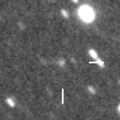
|
Now it is 17.2 mag (May 26, iTelescope Observatory, Siding Spring). It will be fading slowly after this. It is observable in excellent condition in the Southern Hemisphere. It locates low in the Northern Hemisphere.
Date(TT) R.A. (2000) Decl. Delta r Elong. m1 Best Time(A, h)
Aug. 17 14 35.48 -38 44.6 3.567 3.635 85 16.9 20:18 ( 37, 2)
Aug. 24 14 31.21 -38 28.9 3.692 3.632 78 16.9 20:08 ( 41, 0)
|

|
Now it is 16.7 mag (Aug. 7, Toshihiko Ikemura, Hirohisa Sato). It is observable at 17 mag in good condition from August to September.
Date(TT) R.A. (2000) Decl. Delta r Elong. m1 Best Time(A, h)
Aug. 17 1 10.86 29 44.4 1.768 2.366 113 17.0 3:32 ( 0, 85)
Aug. 24 1 0.10 26 15.0 1.673 2.390 124 16.9 2:54 ( 0, 81)
|

|
It has not been observed yet in this apparition. It will brighten up to 16 mag in autumn. It is observable in good condition in the Southern Hemisphere. It locates somewhat low in the Northern Hemisphere.
Date(TT) R.A. (2000) Decl. Delta r Elong. m1 Best Time(A, h)
Aug. 17 18 24.16 -38 54.8 1.238 2.038 129 17.4 20:43 ( 0, 16)
Aug. 24 18 25.14 -37 21.7 1.264 2.009 123 17.2 20:16 ( 0, 18)
|

|
It has not been observed yet in this apparition. It was expected to be observable at 17.5 mag from June to August. But actually, it was fainter than 21.5 mag in March (Mar. 10, Erwin Schwab).
Date(TT) R.A. (2000) Decl. Delta r Elong. m1 Best Time(A, h)
Aug. 17 18 32.05 -20 10.4 1.255 2.089 133 17.7 20:51 ( 0, 35)
Aug. 24 18 34.94 -21 15.0 1.311 2.089 127 17.8 20:26 ( 0, 34)
|
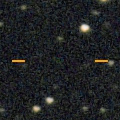
|
It will brighten up to 17.5 mag, and it will be observable in good condition in autumn.
Date(TT) R.A. (2000) Decl. Delta r Elong. m1 Best Time(A, h)
Aug. 17 1 35.46 20 23.2 2.760 3.299 113 17.8 3:48 (353, 75)
Aug. 24 1 36.75 20 33.3 2.678 3.300 119 17.7 3:30 ( 0, 76)
|

|
It will brighten up to 16.5 mag in winter, and it will be observable in good condition. It locates somewhat low in the Southern Hemisphere.
Date(TT) R.A. (2000) Decl. Delta r Elong. m1 Best Time(A, h)
Aug. 17 4 6.46 23 33.4 3.409 3.374 79 17.8 3:48 (277, 54)
Aug. 24 4 12.91 23 52.9 3.302 3.362 84 17.7 3:56 (283, 60)
|

|
Now it is 16.9 mag (July 4, Alexander Baransky). It is observable at 17 mag in good condition in 2019. It locates somewhat low in the Northern Hemisphere.
Date(TT) R.A. (2000) Decl. Delta r Elong. m1 Best Time(A, h)
Aug. 17 15 20.48 -17 9.2 3.883 3.989 88 17.8 20:18 ( 43, 26)
Aug. 24 15 24.52 -17 32.4 3.994 3.998 82 17.8 20:08 ( 45, 23)
|

|
Now it is fading. In 2019, it is observable at 17.5 mag in good condition in autumn.
Date(TT) R.A. (2000) Decl. Delta r Elong. m1 Best Time(A, h)
Aug. 17 2 54.64 11 11.6 3.771 4.055 98 17.8 3:48 (315, 59)
Aug. 24 2 56.12 11 16.6 3.683 4.069 105 17.8 3:56 (329, 63)
|

|
Now it is 17.5 mag (Aug. 7, Toshihiko Ikemura, Hirohisa Sato). It will brighten up to 12 mag in winter in 2022.
Date(TT) R.A. (2000) Decl. Delta r Elong. m1 Best Time(A, h)
Aug. 17 22 34.75 47 19.9 7.511 8.036 117 17.9 0:56 (180, 78)
Aug. 24 22 31.08 47 31.6 7.424 7.991 120 17.9 0:25 (180, 77)
|

|
In the Southern Hemisphere, it is observable at 18 mag in good condition from July to August. It locates low in the Northern Hemisphere.
Date(TT) R.A. (2000) Decl. Delta r Elong. m1 Best Time(A, h)
Aug. 17 20 6.34 -33 42.2 2.708 3.622 150 17.9 22:24 ( 0, 21)
Aug. 24 20 2.79 -33 42.9 2.757 3.619 143 17.9 21:53 ( 0, 21)
|

|
First return of a new periodic comet which brightened up to 17 mag in 2006. It has not been recovered yet in this apparition. It will brighten up to 18 mag in autumn. It is observable in good condition in the Southern Hemisphere. It locates extremely low in the Northern Hemisphere.
Date(TT) R.A. (2000) Decl. Delta r Elong. m1 Best Time(A, h)
Aug. 17 16 29.91 -37 49.9 2.108 2.597 107 17.9 20:18 ( 18, 14)
Aug. 24 16 36.58 -37 25.4 2.166 2.577 102 17.9 20:08 ( 20, 14)
|
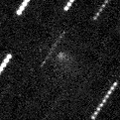
|
It was bright as 16.3 mag in May (May 23, Ken-ichi Kadota). However, it is getting diffused and fading very rapidly in July. The nucleus may be disintegrated. It is observable in excellent condition in the Northern Hemisphere. It is not observable in the Southern Hemisphere.
Date(TT) R.A. (2000) Decl. Delta r Elong. m1 Best Time(A, h)
Aug. 17 13 51.82 42 14.2 2.033 1.766 60 20.5 20:18 (118, 42)
Aug. 24 13 54.37 36 35.2 2.138 1.787 56 21.2 20:08 (112, 38)
|
|
![]()
 260P/McNaught
260P/McNaught C/2017 T2 ( PanSTARRS )
C/2017 T2 ( PanSTARRS ) C/2019 A9 ( PanSTARRS )
C/2019 A9 ( PanSTARRS ) 29P/Schwassmann-Wachmann 1
29P/Schwassmann-Wachmann 1 78P/Gehrels 2
78P/Gehrels 2 C/2018 A6 ( Gibbs )
C/2018 A6 ( Gibbs ) 68P/Klemola
68P/Klemola C/2016 M1 ( PanSTARRS )
C/2016 M1 ( PanSTARRS ) C/2018 R3 ( Lemmon )
C/2018 R3 ( Lemmon ) 322P/SOHO
322P/SOHO C/2017 B3 ( LINEAR )
C/2017 B3 ( LINEAR ) C/2017 M4 ( ATLAS )
C/2017 M4 ( ATLAS ) A/2018 V3
A/2018 V3 261P/Larson
261P/Larson C/2018 F4 ( PanSTARRS )
C/2018 F4 ( PanSTARRS ) A/2017 U7
A/2017 U7 C/2019 K5 ( Young )
C/2019 K5 ( Young ) C/2019 K7 ( Smith )
C/2019 K7 ( Smith ) C/2018 W1 ( Catalina )
C/2018 W1 ( Catalina ) 101P/Chernykh
101P/Chernykh C/2019 K1 ( ATLAS )
C/2019 K1 ( ATLAS ) C/2018 Y1 ( Iwamoto )
C/2018 Y1 ( Iwamoto ) P/2008 Y1 ( Boattini )
P/2008 Y1 ( Boattini ) C/2016 N6 ( PanSTARRS )
C/2016 N6 ( PanSTARRS ) (3200) Phaethon
(3200) Phaethon C/2017 K2 ( PanSTARRS )
C/2017 K2 ( PanSTARRS ) C/2019 D1 ( Flewelling )
C/2019 D1 ( Flewelling ) C/2016 R2 ( PanSTARRS )
C/2016 R2 ( PanSTARRS ) C/2018 A3 ( ATLAS )
C/2018 A3 ( ATLAS ) C/2018 KJ3 ( Lemmon )
C/2018 KJ3 ( Lemmon ) C/2019 K4 ( Ye )
C/2019 K4 ( Ye ) 160P/LINEAR
160P/LINEAR P/2012 K3 ( Gibbs )
P/2012 K3 ( Gibbs ) 200P/Larsen
200P/Larsen 203P/Korlevic
203P/Korlevic 74P/Smirnova-Chernykh
74P/Smirnova-Chernykh 65P/Gunn
65P/Gunn C/2019 L3 ( ATLAS )
C/2019 L3 ( ATLAS ) 215P/NEAT
215P/NEAT P/2006 H1 ( McNaught )
P/2006 H1 ( McNaught ) C/2019 J2 ( Palomar )
C/2019 J2 ( Palomar )![]()
































